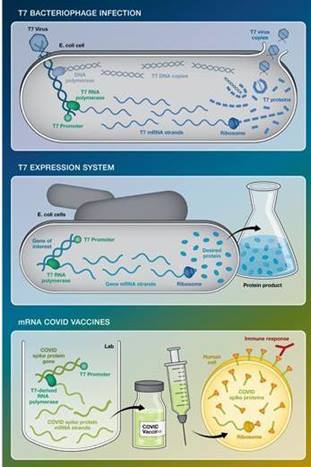
The Science Behind the Shot
Biotech tools developed at Brookhaven Lab in the 1980s were fundamental to making lifesaving mRNA vaccines for COVID-19.

Nearly 100 years of research on DNA has given scientists an incredibly detailed understanding of how DNA and genes, packages of DNA that code for proteins, tell cells what to do. One part of that effort focused on understanding how the genes of a simple virus work together. Now scientists have harnessed this specific genetic knowledge to make a new kind of vaccine to help us fight diseases like COVID-19.
The life-saving mRNA vaccines for COVID-19 use an innovative approach that relies on tools developed in the 1980s at DOE’s Brookhaven National Laboratory. Since inventing vaccines in the late 1700s, doctors have used dead or weakened viruses to prime our bodies’ immune systems. Now, these new mRNA vaccines deliver instructions for making just one crucial COVID protein — the spikes that cover the virus. When our cells read these instructions and make the spike proteins in our own cells, our immune system rallies an army of antibodies and other defenses to attack these apparent “invaders.” This means our defenses are prepared if the real COVID virus comes along.
But how do the vaccine makers make those spike-protein instructions? That’s where the Brookhaven connection comes in.
In the 1980s, a team led by Brookhaven biologist F. William Studier was exploring the T7 bacteriophage, a virus that infects E. coli bacteria, not human cells. T7 injects its genes into E. coli and takes over the bacteria to make many copies of itself.
“I was using T7 to study properties of DNA and decided also to study its molecular genetics and physiology,” Studier said.
In 1983, the team cloned the enzyme (a biological catalyst) that transcribes T7’s genes into messenger RNA (mRNA). mRNA tells ribosomes—the machinery inside cells—which amino acids to link up to build a particular protein.
Studier worked with Parichehre Davanloo, then a postdoctoral fellow, and Alan Rosenberg, a senior lab member, to clone this crucial enzyme. Then John Dunn (now deceased), purified the enzyme, T7 RNA polymerase, and showed that it performed very efficiently, producing large amounts of RNA.

The Brookhaven team and other researchers also discovered powerful T7 promoters—the genetic elements that serve as “start” signals for transcribing genes. Barbara Moffatt, then a graduate student, worked with Studier to turn these discoveries into the T7 expression system. This system uses T7’s prolific copying capability to make things other than more T7 viruses.
“The T7 polymerase can transcribe virtually any gene sequence preceded by a T7 promoter to make large amounts of mRNA,” said Moffatt, now a professor of biology at the University of Waterloo in Canada. “When read by the ribosomes inside E. coli cells, the mRNA’s sequence directs the synthesis of large amounts of the protein encoded by that gene.”
“Scientists around the world have used Bill’s T7 expression system to make large quantities of proteins or RNA of interest for the past four decades,” said Venki Ramakrishnan, a Nobel-Prize-winning biologist from the Medical Research Council Laboratory of Molecular Biology in Cambridge, UK. The system is used in virtually every academic biochemistry lab to produce mRNA and proteins for research, and in the production of a range of pharmaceuticals.
“The mRNA COVID-19 vaccines use precisely this system,” Ramakrishnan said.
At manufacturing plants run by Pfizer/BioNTech and Moderna, T7-derived promoters and enzymes crank out kilograms of spike-protein mRNA at a time. But instead of translating the mRNA into spike proteins inside bacteria, the pharmaceutical scientists modify it and encapsulate it so it can be injected into our arms. Then our ribosomes translate the mRNA instructions, making spikes that prime our bodies to fight COVID-19.
“The T7 polymerase and promoter are so efficient, they make it possible to produce enough mRNA for millions of vaccine doses at a time,” said John Shanklin, current chair of Brookhaven Lab’s Biology Department. “Bill’s discoveries played a huge role in making it possible to rapidly scale up production to protect people around the world.”
The fundamental T7 research at Brookhaven Lab was supported by the DOE Office of Science, Office of Biological and Environmental Research.
This article was created in partnership with Brookhaven National Laboratory, learn more about their work.
Read more stories in the Basic2Breakthrough series.


